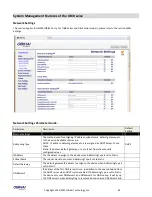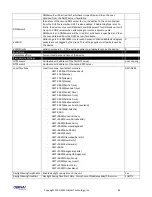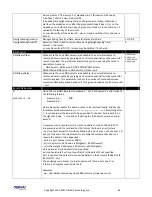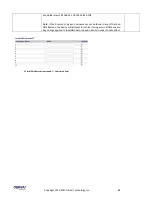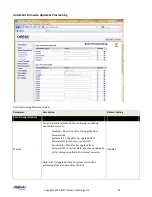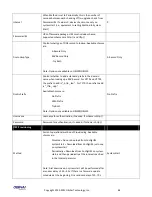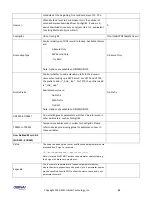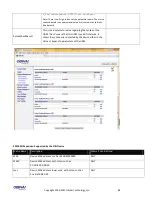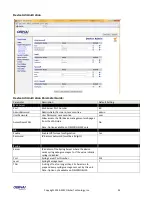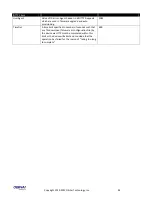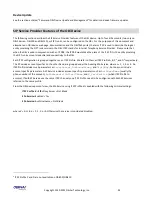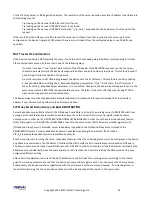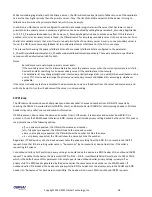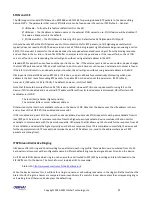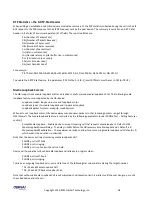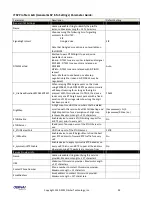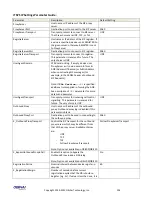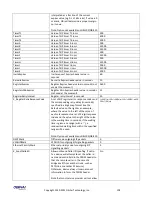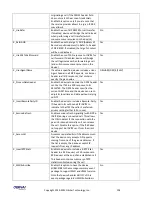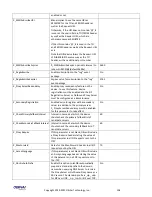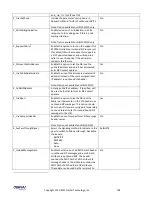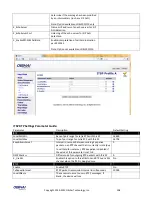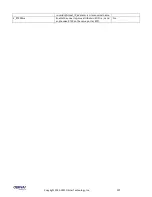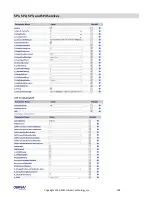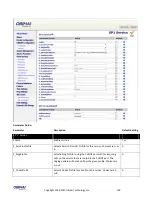
Copyright 2010-2013 Obihai Technology, Inc.
95
of the SIP Proxy Server or SIP Registration Server. The resolution of the server domain name into IP address is performed in
the following manner:
-
Try looking up the name as DNS A Record. If not found.
-
Try looking up the name as DNS SRV Record. If not found.
-
Try looking up the name as DNS SRV Record with “_sip._udp. “ prepended to the hostname. If not found, fail the
request.
If the result from the DNS query is a SRV record, the server port is taken from that record also (the server port value
configured on the device is ignored). Otherwise, the server port is taken from the configured value or use 5060 if none
specified.
NAT Traversal Considerations
If the device sits behind a NAT (typically the case), it can discover the mapped external address corresponding to its local
SIP contact address as seen by the server in one of the following ways:
-
From the “received=” and “rport=” parameters of the VIA header of the REGISTER response sent by the server;
these two parameters tells the device its mapped IP address and port number respectively. This method is used if
periodic registration is enabled on the device
-
From the response to a STUN binding request the device sent to a STUN server. This method is used by enabling
X_KeepAliveEnable and setting the X_KeepAliveMsgType parameter to “stun”. In that case, the STUN server is
taken from the X_KeepAliveServer parameter, if it is specified. Otherwise, the keep-alive messages are sent to the
same server where a REGISTER request would be sent to. The latter is the most effective way of using STUN to
discover the mapped external contact address
The device always uses the mapped external contact address in all outbound SIP requests instead of its local contact
address if one is discovered by either method discovered above.
SIP Proxy Server Redundancy and Dual REGISTRATION
Server Redundancy specifically refers to the OBi device’s capability to a) look for a working server to REGISTER with from
among a list of candidates, and b) switch to another server once the server that it currently registers with becomes
unresponsive. In other words, DEVICE REGISTRATION MUST BE ENABLED in order to use the server redundancy feature.
Other SIP requests, such as INVITE or SUBSCRIBE, are sent to the same server that the device currently registers with.
If Outbound Proxy Server is provided, server redundancy is applied to the Outbound Proxy Server instead of the
REGISTRATION server. Server redundancy behavior is enabled by enabling the parameter ITSP Profile X –
SIP::X_ProxyServerRedundancy (which is disabled by default).
Another requirement for using the server redundancy feature is that the underlying server must be configured in the device
as a domain name instead of an IP address. This allows the OBi to collect a list of candidate servers based on DNS query.
The domain name may be looked up as DNS A record or DNS SRV record. For A records, all the IP addresses returned by the
DNS server are considered to have the same priority. For SRV records, the hosts returned by the DNS server can be each
assigned a different priority.
After a list of candidate servers are obtained, the OBi device will first look for a working server according to the stated
priority. A
working server
means one that the device can successfully registers with. This is known as the
Primary Server
.
Subsequently, the device maintains registration with the primary server the usual way. However, if no working server is
found after traversing the entire list, device takes a short break and repeats the search in the same order.
Summary of Contents for OBi100
Page 54: ...Copyright 2010 2013 Obihai Technology Inc 54...
Page 55: ...Copyright 2010 2013 Obihai Technology Inc 55...
Page 58: ...Copyright 2010 2013 Obihai Technology Inc 58...
Page 75: ...Copyright 2010 2013 Obihai Technology Inc 75...
Page 100: ...Copyright 2010 2013 Obihai Technology Inc 100...
Page 109: ...Copyright 2010 2013 Obihai Technology Inc 109 SP1 SP2 SP3 and SP4 Services...
Page 126: ...Copyright 2010 2013 Obihai Technology Inc 126...
Page 135: ...Copyright 2010 2013 Obihai Technology Inc 135...
Page 140: ...Copyright 2010 2013 Obihai Technology Inc 140...
Page 157: ...Copyright 2010 2013 Obihai Technology Inc 157...
Page 158: ...Copyright 2010 2013 Obihai Technology Inc 158...
Page 159: ...Copyright 2010 2013 Obihai Technology Inc 159...
Page 174: ...Copyright 2010 2013 Obihai Technology Inc 174...
Page 185: ...Copyright 2010 2013 Obihai Technology Inc 185...

